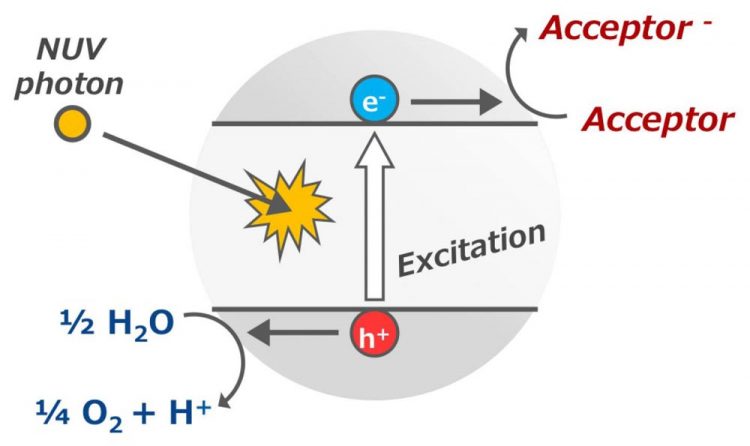Oxygen is not definitive evidence of life on habitable extrasolar planets

Abiotic oxygen can be produced from water in the presence of titanium oxide and an electron acceptor under UV light. Our report suggests that this photocatalytic reaction can supply significant amount of abiotic oxygen on habitable extrasolar planets. Credit: National Institutes of Natural Sciences (NINS)
But now, a research assistant professor Norio Narita of the Astrobiology Center of National Institutes of Natural Sciences (NINS), which was founded in April 2015, and an associate professor Shigeyuki Masaoka, of the Institute of Molecular Science of NINS, have presented a novel hypothesis that it could be possible for planets to have large quantities of abiotic (non-biologically produced) oxygen.
This study is a good example of interdisciplinary studies that combine knowledge from different fields of science to promote astrobiology in the search for life on extrasolar planets. The study is published in Scientific Reports on Sep 10, 2015.
Until now, it had been thought that if a planet has oxygen, that must mean that some form of plants are producing it through photosynthesis. Therefore, it had been assumed that when searching for signs of life on habitable extrasolar planets, the presence of oxygen in the atmosphere could be considered a definitive biomarker.
However, non-biological chemical reactions can also affect atmospheric compositions of extrasolar planets. Now, the research team led by Dr. Narita has shown that, abiotic oxygen produced by the photocatalytic reaction of titanium oxide, which is known to be abundant on the surfaces of terrestrial planets, meteorolites, and the Moon in the Solar System, cannot be discounted.
For a planet with an environment similar to the Sun-Earth system, continuous photocatalytic reaction of titanium oxide on about 0.05 % of the planetary surface could produce the amount of oxygen found in the current Earth's atmosphere. In addition, the team estimated the amount of possible oxygen production for habitable planets around other types of host stars with various masses and temperatures.
They found that even in the least efficient production case of a low-temperature star, the photocatalytic reaction of the titanium oxide on about 3% of the planetary surface could maintain this level of atmospheric oxygen through abiotic processes. In other words, it is possible that a habitable extrasolar planet could maintain an atmosphere with Earth-like oxygen, even without organisms to perform photosynthesis.
Dr. Narita said, “To search for life on extrasolar planets through astronomical observation, we need to combine the knowledge from various scientific fields and to promote astrobiology researches to establish the decisive signs of life. Although oxygen is still one of possible biomarkers, it becomes necessary to look for new biomarkers besides oxygen from the present result.”
###
Article:
Title: Titania may produce abiotic oxygen atmospheres on habitable exoplanets
Authors: Norio Narita1,2,3, Takafumi Enomoto3,4, Shigeyuki Masaoka3,4, Nobuhiko Kusakabe2
Affiliation: 1. Astrobiology Center, 2: National Astronomical Observatory of Japan, 3: SOKENDAI (The Graduate University for Advanced Studies), 4:Institute for Molecular Science
Scientific Reports, 2015 Sep 10
Contact Information:
Science Contact:
Astrobiology Center, National Institutes of Natural Sciences
Research Assistant Professor
Dr. Norio Narita
E-mail: norio.narita@nao.ac.jp
Tel: +81-422-34-3543,
PR Contact:
National Institutes of Natural Sciences
E-mail a.koizumi@nins.jp (Dr. Amane Koizumi)
nins-kikakurenkei@nins.jp
TEL: +81-3-5425-1898 FAX +81-3-5425-2049
National Astronomical Observatory of Japan
Chief Public Information Officer,
Dr. Masaaki Hiramatsu
Email: hiramatsu.masaaki@nao.ac.jp
Public Relations, Institute for Molecular Science, Natural Institutes of Natural Sciences
E-mail: kouhou@ims.ac.jp
TEL/FAX?+81-564-55-7262
Media Contact
All latest news from the category: Physics and Astronomy
This area deals with the fundamental laws and building blocks of nature and how they interact, the properties and the behavior of matter, and research into space and time and their structures.
innovations-report provides in-depth reports and articles on subjects such as astrophysics, laser technologies, nuclear, quantum, particle and solid-state physics, nanotechnologies, planetary research and findings (Mars, Venus) and developments related to the Hubble Telescope.
Newest articles

Bringing bio-inspired robots to life
Nebraska researcher Eric Markvicka gets NSF CAREER Award to pursue manufacture of novel materials for soft robotics and stretchable electronics. Engineers are increasingly eager to develop robots that mimic the…

Bella moths use poison to attract mates
Scientists are closer to finding out how. Pyrrolizidine alkaloids are as bitter and toxic as they are hard to pronounce. They’re produced by several different types of plants and are…

AI tool creates ‘synthetic’ images of cells
…for enhanced microscopy analysis. Observing individual cells through microscopes can reveal a range of important cell biological phenomena that frequently play a role in human diseases, but the process of…





















